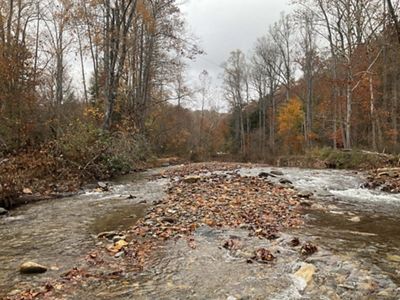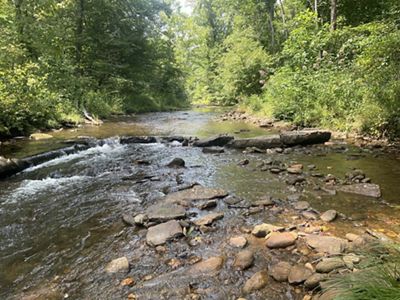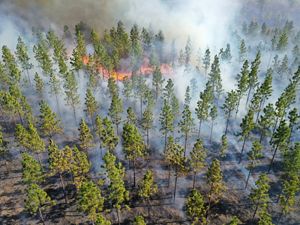The Impacts of Hurricane Helene
TNC is assessing how to move forward in western North Carolina
The images and videos of flooding in North Carolina’s mountains began to show up on social media before Hurricane Helene’s eye had even made landfall in Florida. Video clips showing cars and houses being swept away and familiar landmarks completely underwater seemed almost impossible to believe.
By Saturday, September 28, the sheer scale of the devastation to communities throughout the Southern Appalachians began to emerge. All eyes were on people’s physical safety and mental well-being and on ensuring basic needs like housing, food, water and communications were being met.
The Nature Conservancy’s seven staff and 20 fire crew who live in the region, along with their families and homes, came through this ordeal, but all experienced days without power, up to 57 days without potable water, unpassable roads and upheaval in their day-to-day lives. (Read Nature Conservancy magazine Deputy Editor Eric Seeger's firsthand account from Asheville.)
As the state emerges from this horrific event, TNC is continuing to take stock of the impacts on the lands, waters and wildlife we are working to protect.
Forests
Our preserves in Ashe County came out relatively unscathed. Bluff Mountain and the New River headwaters are at the northern end of the area heavily impacted by Helene. Across the region, eastern slopes that were most exposed to westward winds suffered the most damage.
Many of our initial assessments had to be made by drone footage from GIS Coordinator Margaret Fields. Since then, TNC Assistant Land Steward Brian Parr has been to all of our preserves, although some areas are still inaccessible due to considerable damage of their access roads.
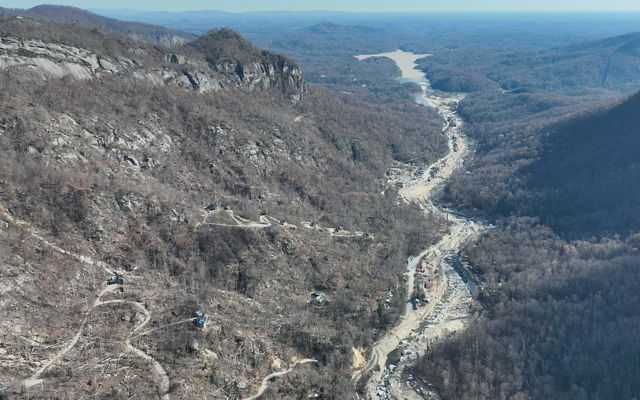
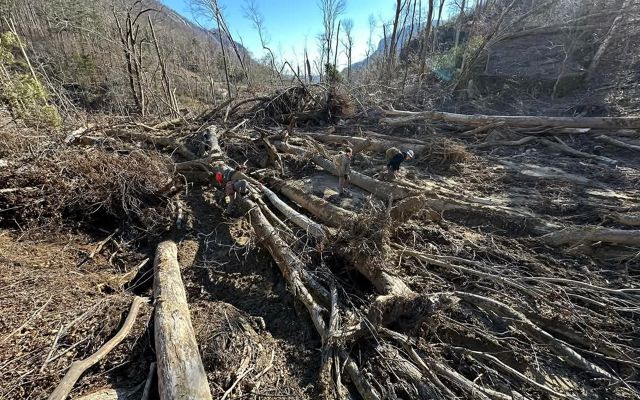

Bat Cave Preserve, located in Hickory Nut Gorge, was not as lucky and suffered extensive damage. Because of its unique mountain topography, rain funneled into the narrow gorge, leading to some of the worst flooding experienced in the region, including the extensive destruction seen in Chimney Rock Village. (Watch: The Chimney Rock video [31:08] by geologist Phillip Prince provides a great explanation of the extreme flooding around Chimney Rock.)
The interior of the preserve is still completely inaccessible, but we know there were at least two large landslides and more than 30 acres of catastrophic forest blowdown on the preserve’s 85 acres. Additionally, the pedestrian bridge across the Broad River, which served as the primary access point to the preserve, washed away. The river here carved an entirely new channel, and the footprint of the riverbed shifted onto what had been U.S. Highway 64.

The more than 800,000 acres of timberland damaged in the storm present new unique challenges as wildfire season ramps up. The tens of thousands of downed trees create a lot of potential fuel on the forest floor. Without a closed canopy, the wood will dry out more quickly, and species that burn hotter can flourish. The downed trees also block access points that could make it harder to reach fires that need attention.
We are grateful to the TNC staff, seasonal fire crew and partners in the region who are working quickly to clean up debris, create fire lines and secure road access.

Wetlands and Bogs
Our fragile bogs in Ashe and Henderson counties have suffered various degrees of damage, especially from significant amounts of gravel that washed in. These bogs are home to threatened endangered species, such as bog turtles, mountain sweet pitcher plants and purple mountain pitcher plants.
In the Bluff Valley Wetlands, TNC has funded sediment removal operations. Small equipment will remove most of the sediment and gravel, but because the wetlands are so fragile, the remainder will be removed by hand. This is incredibly hard work, and we are grateful for the help of the NC Wildlife Resources Commission’s (WRC) field staff and volunteers.
At Ida’s Bog, home to one of the biggest known populations of bog turtles, more than a foot of water washed in. NC WRC is also leading an effort to remove sediment by hand from the main turtle habitat area. TNC is funding the repair of fencing that helps guide animals to a recently installed under-road wildlife crossing. At South Beaver Creek, in addition to sediment removal, we are undertaking a restoration project using locally sourced native plants to stabilize eroding streambanks.
At all three sites, our partner Amphibian and Reptile Conservancy is leading efforts to assess and monitor the current turtle populations, protect nests and assist with habitat management. Bog turtles hibernate until early April, so we will learn a lot more about how they fared after Hurricane Helene in the next few months.
Freshwater Systems
Hurricane Helene was a geomorphic event that triggered hundreds of landslides, reshaped landscapes and carved new river channels. Because of this, much of the work TNC was doing on fresh water in the region, such as working with the U.S. Forest Service to develop watershed restoration action plans (WRAPs), needed to be reevaluated. The WRAPs, which outline projects that aim to make our watersheds more resilient in the face of climate change, now need new data on the changes within the watersheds, such as landslide locations, road-stream crossing conditions, biodiversity and even the new footprints of riverbeds.
Not surprisingly, since the hurricane, the list of projects has gotten longer. For example, many culverts that were not barriers to aquatic passage before the storm now likely need attention. The nearly 2,000 landslides reported across the state damaged road systems and river crossings and could contribute sediment to the freshwater system for years to come.
TNC has spent the last several months working with partners trying to locate areas of damage and assess and identify gaps in survey coverage, and this work will continue.
Watch below as NC Mountains Freshwater Specialist Lucie Law discusses how the storm worked to reconnect the floodplain in one area.
Join Our Rebuilding Efforts!
We are raising $1 million for Hurricane Helene recovery efforts in NC's mountains. These funds will go to road engineering and repair, river restoration, creating fire lines and more. Will you make a special gift?

